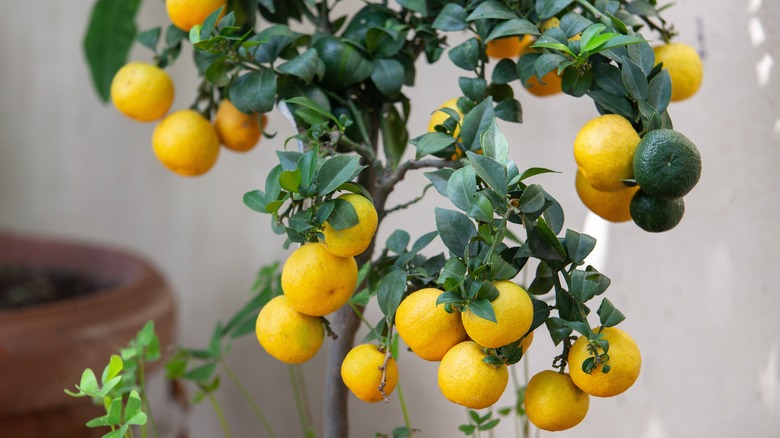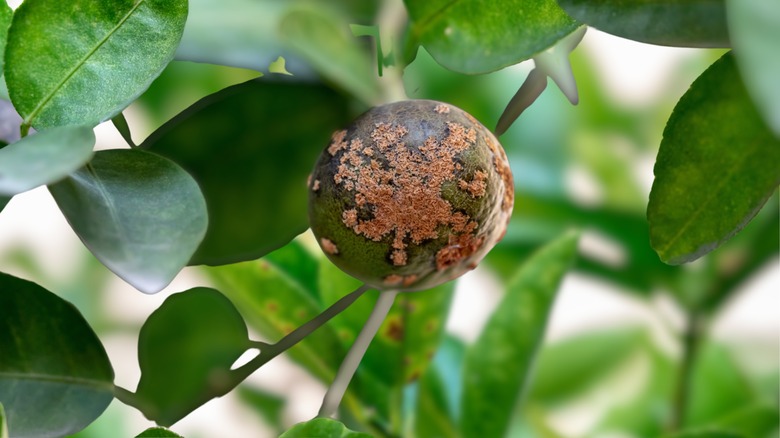Common Diseases You Should Know About Before Growing Lemon Trees
The artistically sculpted stems, ovate red to green foliage, four-season flowers, and fragrant, zesty fruits have many home gardeners convinced that lemon trees (Citrus x limon) have a place in their backyard. If space is short, they resort to making their mini lemon tree grow like a bonsai for aesthetics. Unfortunately, growing the true acid fruit-bearing trees isn't like the good-humored "easy-peasy lemon-squeezy" phrase suggests. Instead, it's a major investment and a labor of love. We aren't speaking of the multitude of reasons why that lemon tree is struggling in your garden. Poor watering practices, nutritional deficiencies, and improper pest management ails trees aplenty. Instead, the crux is the vulnerability of citrus trees to diseases like scab, canker, yellow shoot disease, tristeza, and greasy spot.
It appears humans aren't the lone organisms who find lemon trees irresistible; disease-carrying pests and pathogens do, too. The U.S. Department of Agriculture recognizes diseases like citrus greening, citrus canker, and citrus black spot as major scourges affecting citrus trees. Their chokehold is terrible, with most infected trees dying within a few years. Worse, these contagious diseases spill over from homes to commercially grown groves, hurting lemon production. So, before planting lemon trees, learn about the common illnesses they'll be susceptible to and learn how to offset this with good gardening practices and screening regularly for signs of disease.
Yellow shoot disease can massacre lemon trees
Since its discovery in 2005, yellow shoot disease, or Huanglongbing, has devastated lemon trees en masse in its habitable region, including Florida, Georgia, California, South Carolina, and more. The citrus greening disease is truly ferocious as it keeps its presence hidden initially. Even if caught on early, it's often mistaken for the relatively benign nutritional deficiencies of zinc, nitrogen, iron, or the like. However, unlike them, it exhibits uneven, asymmetrical chlorotic leaves, otherwise coined "blotchy mottle," that may later lose their verdant hue completely. Such patterns usually dominate a particular section of the specimen. As for the lemons, they remain small, deformed, and green, tasting awfully sour. The worst part? Yellow shoot disease is incurable, so you're bound to watch the lemon tree die a slow death over five years.
Given citrus greening's severity, it's no surprise that many home gardeners steer clear of lemon trees, especially if they live in areas with high disease incidence. Others may plant them if they're up to controlling the population of Asian citrus psyllid, the pest that carries Candidatus liberibacter, the bacteria that causes the disease. This means scouting for the insects, especially their almond-like eggs, in the foliage throughout the year. Homeowners can also use individual protective covers to shield young trees from psyllids. Planting sweet alyssums under your citrus trees may help. To minimize the risk of planting a bacteria-contaminated grafted tree, restrict your purchases to certified nurseries.
Citrus scab defaces the fruits
Mistaken for wind damage, citrus scab's presence is characterized by upstretched, pinkish-tan round warts that grow on the lemon tree's stems and foliage in their budding stage. If left unattended, Elsinoe fawcetti — the disease-causing fungus — can envelop the nascent fruits in tawny-hued lesions until they're over two months old. The lumps eventually sour into slate grays, disfiguring the tangy lemons completely — they're often accompanied by analogous depressions on the undersides. However, the fruit remains palatable.
Endemic in southern states like Florida and Louisiana, citrus scab materializes after heavy rains or too much overhead irrigation, causing the spores to splash up onto the tree. The symptoms become apparent within a week if the temperatures are hovering around 70 to 80 degrees Fahrenheit. General spray treatments are another way for the fungus to hitchhike a ride to the zesty fruits. Fortunately, timely spraying of copper fungicides over lemon trees can moderately prevent the disease from amplifying the next season if you amputate all infected plant parts. Apply the fungicide when the trees regain at least a fourth of their leafy strength around spring, and follow up with a second application after they deflower. After three weeks, spray a final time, especially if the spores have colonized the tree critically. Keep the tree pruned to ensure adequate air circulation and prevent the fungus from harboring dead limbs.
Citrus canker severely weakens lemon trees
Despite decades of battling the bacterium Xanthomonas citri and agencies imposing quarantines, citrus canker has since spread in Florida, Louisiana, Texas, and Alabama. Journeying through the wind, insect action, or on tainted equipment, the bacteria lies in wait for months on the lemon trees for conditions to turn favorable. Right after temperatures soar and a bout of rain splashes down, it starts working its way through the shoots and foliage, culminating at the citrus fruits. Brown protuberances marked in golden halos on both sides give away the infestation. In time, the halos are lost, the oily-margined brown marks turn into scabs, and the fruits fall prematurely. Citrus leaf miners worsen the condition because they open new wounds (or doorways) for the tree-wrecking microbe. That's why Californians must remain on the lookout for the disease, as leaf miners run the gamut in their area. Ultimately, the tree defoliates, losing its productivity.
So how to grow lemon trees safely without letting the disease in? Stick to growing USDA-certified lemon trees and situate them in sunny sites. Don't irrigate from the top, lest the bacteria turn active (they die in dry conditions). Always decontaminate gardening equipment with a bleach solution after using them. Set up windbreaks because winds slowing down to under 20 miles per hour can stall the disease's advances. Lastly, continuously keep the famished leaf miner larvae in check with petroleum oil during summer. If all else fails, copper sprays may be useful.
Citrus tristeza virus causes twig dieback in lemon trees
Sporting three different strains with varied consequences, including rapid death or stem dieback, the citrus tristeza virus is another disease that can potentially decimate the lemon trees growing in residential landscapes in and around California and Florida. It usually starts as any other rot disease, with the trees defoliating early or discolored foliage. Sometimes, the stems may wither as well. Younglings might surprise their growers by profusely fruiting a year earlier than scheduled, although the lemons will be unusually small, and remain so throughout. In late summer, though, the lemon trees may demand copious amounts of water, owing to the early death of their feeder roots. If unmet, it may kill the citrus tree.
Tristeza virus incidence is mostly a consequence of a bud union gone wrong, such as when scions are attached to more disease-prone rootstocks like rough lemons, citrus macrophylla, or alemeow. It generally shows up as a girdling of roots around the joint. Alternatively, pests like brown citrus aphids, melon aphids, and spirea aphids can encourage such strains. Buying lemon trees from certified nurseries should stave off some danger. Also, stay on top of your pest management game by regularly hosing down aphids and baiting their protectors, like ants, away from your yard.
Greasy spot thins out lemon tree's canopy
Most lemon tree growers are sure to grapple with the greasy spot disease, courtesy of Zasmidium citri-griseum (previously Mycosphaerella citri), a fungal pathogen. It shows up in the beginning as yellow blisters that age into unsightly browns on the green leaves, while the undersides are speckled with orange spots. Strangely, the foliage remains oily-smooth in spite of the raised lesions. If the leaves feel rough and cracked, chances are they're suffering from melanose, another citrus disease. If left untreated, it will lead to leaf drop, stunting the tree's growth and raising its vulnerability to winter and pest damage. Unlike the aforementioned diseases, greasy spot doesn't spare mature trees. Rarely, this disease may assume the form of rind blotch, wherein the fruits show pink specks that eventually turn into black, necrotic tissue.
However, greasy spot's symptoms become apparent much later. While the spores germinate between April and July when they encounter wet, dewy, and humid conditions, they take their sweet time suffocating the leafy growth, delaying their diagnosis to peak winter months (as late as February). So they can only be controlled during the new spring growth with horticultural oil or copper fungicides. Depending on the disease's severity, another application may be necessary in the summer (between July and August). You must also get rid of the dead leaves to reduce the population of the fungal spores.





